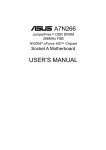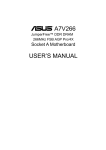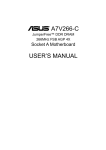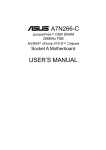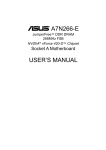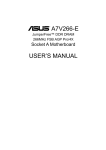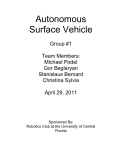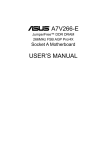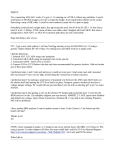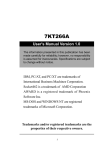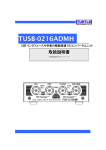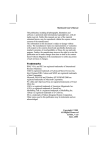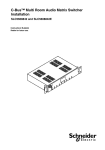Download AMD ASUS A7M266 Socket A ATX Motherboard w/ Audio
Transcript
® A7M266 266MHz FSB DDR RAM AGP Pro Socket A Motherboard USER’S MANUAL USER'S NOTICE No part of this manual, including the products and software described in it, may be reproduced, transmitted, transcribed, stored in a retrieval system, or translated into any language in any form or by any means, except documentation kept by the purchaser for backup purposes, without the express written permission of ASUSTeK COMPUTER INC. (“ASUS”). ASUS PROVIDES THIS MANUAL “AS IS” WITHOUT WARRANTY OF ANY KIND, EITHER EXPRESS OR IMPLIED, INCLUDING BUT NOT LIMITED TO THE IMPLIED WARRANTIES OR CONDITIONS OF MERCHANTABILITY OR FITNESS FOR A PARTICULAR PURPOSE. IN NO EVENT SHALL ASUS, ITS DIRECTORS, OFFICERS, EMPLOYEES OR AGENTS BE LIABLE FOR ANY INDIRECT, SPECIAL, INCIDENTAL, OR CONSEQUENTIAL DAMAGES (INCLUDING DAMAGES FOR LOSS OF PROFITS, LOSS OF BUSINESS, LOSS OF USE OR DATA, INTERRUPTION OF BUSINESS AND THE LIKE), EVEN IF ASUS HAS BEEN ADVISED OF THE POSSIBILITY OF SUCH DAMAGES ARISING FROM ANY DEFECT OR ERROR IN THIS MANUAL OR PRODUCT. Product warranty or service will not be extended if: (1) the product is repaired, modified or altered, unless such repair, modification of alteration is authorized in writing by ASUS; or (2) the serial number of the product is defaced or missing. Products and corporate names appearing in this manual may or may not be registered trademarks or copyrights of their respective companies, and are used only for identification or explanation and to the owners’ benefit, without intent to infringe. • AMD, Athlon™ are trademarks of Advanced Micro Devices, Inc. • VIA is a trademark of VIA Technologies, Inc. • Windows and MS-DOS are registered trademarks of Microsoft Corporation. • Adobe and Acrobat are registered trademarks of Adobe Systems Incorporated. • Trend and ChipAwayVirus are trademarks of Trend Micro, Inc. • Other company and product names may be trademarks or registered trademarks of the respective companies with which they are associated. The product name and revision number are both printed on the product itself. Manual revisions are released for each product design represented by the digit before and after the period of the manual revision number. Manual updates are represented by the third digit in the manual revision number. For previous or updated manuals, BIOS, drivers, or product release information, contact ASUS at http://www.asus.com.tw or through any of the means indicated on the following page. SPECIFICATIONS AND INFORMATION CONTAINED IN THIS MANUAL ARE FURNISHED FOR INFORMATIONAL USE ONLY, AND ARE SUBJECT TO CHANGE AT ANY TIME WITHOUT NOTICE, AND SHOULD NOT BE CONSTRUED AS A COMMITMENT BY ASUS. ASUS ASSUMES NO RESPONSIBILITY OR LIABILITY FOR ANY ERRORS OR INACCURACIES THAT MAY APPEAR IN THIS MANUAL, INCLUDING THE PRODUCTS AND SOFTWARE DESCRIBED IN IT. Copyright © 2001 ASUSTeK COMPUTER INC. All Rights Reserved. Product Name: ASUS A7M266 Manual Revision: 1.04 E776 Release Date: May 2001 2 ASUS A7M266 User’s Manual ASUS CONTACT INFORMATION ASUSTeK COMPUTER INC. (Asia-Pacific) Marketing Address: Telephone: Fax: Email: 150 Li-Te Road, Peitou, Taipei, Taiwan 112 +886-2-2894-3447 +886-2-2894-3449 [email protected] Technical Support MB/Others (Tel): +886-2-2890-7121 (English) Notebook (Tel): +886-2-2890-7122 (English) Desktop/Server (Tel):+886-2-2890-7123 (English) Fax: +886-2-2893-7775 Email: [email protected] WWW: www.asus.com.tw FTP: ftp.asus.com.tw/pub/ASUS ASUS COMPUTER INTERNATIONAL (America) Marketing Address: Fax: Email: 6737 Mowry Avenue, Mowry Business Center, Building 2 Newark, CA 94560, USA +1-510-608-4555 [email protected] Technical Support Fax: Email: WWW: FTP: +1-510-608-4555 [email protected] www.asus.com ftp.asus.com/Pub/ASUS ASUS COMPUTER GmbH (Europe) Marketing Address: Fax: Email: Harkortstr. 25, 40880 Ratingen, BRD, Germany +49-2102-442066 [email protected] (for marketing requests only) Technical Support Hotline: Fax: Support (Email): WWW: FTP: MB/Others: +49-2102-9599-0 Notebook: +49-2102-9599-10 +49-2102-9599-11 www.asuscom.de/de/support (for online support) www.asuscom.de ftp.asuscom.de/pub/ASUSCOM ASUS A7M266 User’s Manual 3 CONTENTS 1. INTRODUCTION 7 1.1 How This Manual Is Organized ................................................... 7 1.2 Item Checklist .............................................................................. 7 2. FEATURES 8 2.1 The ASUS A7M266 ..................................................................... 8 2.1.1 Specifications ..................................................................... 8 2.1.2 Specifications – Optional Components .............................. 9 2.1.3 Special Features ................................................................ 10 2.1.4 Performance Features ....................................................... 10 2.1.5 Intelligence ....................................................................... 11 2.2 Motherboard Components .......................................................... 12 2.2.1 Component Locations ....................................................... 13 3. HARDWARE SETUP 14 3.1 Motherboard Layout .................................................................. 14 3.2 Layout Contents ......................................................................... 15 3.3 Getting Started ........................................................................... 17 3.4 Motherboard Settings ................................................................. 18 3.5 System Memory (DDR DIMM) ................................................. 25 3.5.1 General DIMM Notes ....................................................... 26 3.5.2 Memory Installation ......................................................... 26 3.6 Central Processing Unit (CPU) .................................................. 27 3.7 Expansion Cards ........................................................................ 28 3.7.1 Expansion Card Installation Procedure ............................ 28 3.7.2 Assigning IRQs for Expansion Cards .............................. 30 3.7.3 Accelerated Graphics Port Pro (AGP Pro) ....................... 30 3.7.4 Audio Modem Riser (AMR) Slot ..................................... 32 3.8 External Connectors ................................................................... 33 3.9 Starting Up the First Time .......................................................... 45 4. BIOS SETUP 47 4.1 Managing and Updating Your BIOS .......................................... 47 4.1.1 Upon First Use of the Computer System .......................... 47 4.1.2 Updating BIOS Procedures .............................................. 48 4.2 BIOS Setup Program .................................................................. 51 4.2.1 BIOS Menu Bar ................................................................ 52 4.2.2 Legend Bar ....................................................................... 52 4 ASUS A7M266 User’s Manual CONTENTS 4.3 Main Menu ................................................................................. 54 4.3.1 Primary & Secondary Master/Slave ................................. 55 4.3.2 Keyboard Features ............................................................ 58 4.4 Advanced Menu ......................................................................... 60 4.4.1 Chip Configuration ........................................................... 63 4.4.2 I/O Device Configuration ................................................. 66 4.4.3 PCI Configuration ............................................................ 69 4.4.4 Shadow Configuration ...................................................... 73 4.5 Power Menu ............................................................................... 74 4.5.1 Power Up Control ............................................................. 76 4.5.2 Hardware Monitor ............................................................ 78 4.6 Boot Menu ................................................................................. 79 4.7 Exit Menu ................................................................................... 81 5. SOFTWARE SETUP 83 5.1 Install Operating System ............................................................ 83 5.2 Start Windows ............................................................................ 83 5.3 A7 Series Motherboard Support CD .......................................... 83 5.4 Uninstalling Programs................................................................ 85 6. SOFTWARE REFERENCE 87 6.1 ASUS PC Probe ......................................................................... 87 6.2 ASUS Update ............................................................................. 92 6.3 YAMAHA XGPlayer ................................................................. 93 7. APPENDIX 97 7.1 Modem Riser .............................................................................. 97 7.2 Glossary ..................................................................................... 99 ASUS A7M266 User’s Manual 5 FCC & DOC COMPLIANCE Federal Communications Commission Statement This device complies with FCC Rules Part 15. Operation is subject to the following two conditions: • • This device may not cause harmful interference, and This device must accept any interference received, including interference that may cause undesired operation. This equipment has been tested and found to comply with the limits for a Class B digital device, pursuant to Part 15 of the FCC Rules. These limits are designed to provide reasonable protection against harmful interference in a residential installation. This equipment generates, uses and can radiate radio frequency energy and, if not installed and used in accordance with manufacturer's instructions, may cause harmful interference to radio communications. However, there is no guarantee that interference will not occur in a particular installation. If this equipment does cause harmful interference to radio or television reception, which can be determined by turning the equipment off and on, the user is encouraged to try to correct the interference by one or more of the following measures: • • • • Re-orient or relocate the receiving antenna. Increase the separation between the equipment and receiver. Connect the equipment to an outlet on a circuit different from that to which the receiver is connected. Consult the dealer or an experienced radio/TV technician for help. WARNING! Any changes or modifications to this product not expressly approved by the manufacturer could void any assurances of safety or performance and could result in violation of Part 15 of the FCC Rules. Reprinted from the Code of Federal Regulations #47, part 15.193, 1993. Washington DC: Office of the Federal Register, National Archives and Records Administration, U.S. Government Printing Office. Canadian Department of Communications Statement This digital apparatus does not exceed the Class B limits for radio noise emissions from digital apparatus set out in the Radio Interference Regulations of the Canadian Department of Communications. This Class B digital apparatus complies with Canadian ICES-003. Cet appareil numérique de la classe B est conforme à la norme NMB-003 du Canada. 6 ASUS A7M266 User’s Manual 1. INTRODUCTION 1. INTRODUCTION Manual / Checklist 1.1 How This Manual Is Organized This manual is divided into the following sections: 1. 2. 3. 4. 5. 6. 7. INTRODUCTION FEATURES HARDWARE SETUP BIOS SETUP SOFTWARE SETUP SOFTWARE REFERENCE APPENDIX Manual information and checklist Production information and specifications Instructions on setting up the motherboard. Instructions on setting up the BIOS Instructions on setting up the included software Reference material for the included software Optional items and general reference 1.2 Item Checklist Check that your package is complete. If you discover damaged or missing items, contact your retailer. Optional Items Package Contents ASUS CIDB chassis intrusion detec(1) ASUS Motherboard tion module (1) 40-pin 80-conductor ribbon ASUS IrDA-compliant infrared cable for internal UltraDMA/ module 100 / UltraDMA/66 (also compatible with UltraDMA/33 ASUS MR-I Modem Riser Card IDE drives/devices) (1) Ribbon cable for internal UltraDMA/33 IDE drives (1) Ribbon cable for one 5.25” and two 3.5” floppy disk drives (1) ASUS 2-port USB Connector Set (1) Bag of spare jumper caps (1) ASUS Support CD with drivers and utilities (1) This Motherboard User’s Manual ASUS A7M266 User’s Manual 7 2. FEATURES 2.1 The ASUS A7M266 The ASUS A7M266 motherboard is carefully designed for the value-conscious PC user who wants advanced features processed by the fastest processors. 2.1.1 Specifications • 2. FEATURES Specifications • • • • • • • • • • 8 AMD Athlon™/Duron™ Processor Support: Supports Socket A-based AMD Athlon™/Duron™ processors. North Bridge System Chipset: AMD-761™ chipset with AGP/PCI/Memory controller supports a 266MHz Front Side Bus (FSB), supports DDR SDRAM DIMM, complies with AGP 2.0 specifications for 4X, 2X and 1X AGP modes and PCI 2.2. bus interface with support for 5 PCI masters. It is optimized to deliver enhanced AMD Athlon™ processor system performance. “Super South” South Bridge System PCIset: VIA VT82C686B PCIset with PCI Super-I/O Integrated Peripheral Controller (PSIPC) with support for UltraDMA/100, which allows burst mode data transfer rates of up to 100MB/sec; AC97 audio; USB controller with root hub and four function ports. PC2100 / PC1600 DDR SDRAM Support: Equipped with two Double Data Rate Dual Inline Memory Module (DDR DIMM) sockets to support up to 2GB of DDR SDRAM. DDR SDRAM is the newest memory standard with the highest bandwidth and lowest latency currently available and dramatically improves the memory system’s ability to service, among others, high multimedia requirements. Stepless Frequency Selection: Allows CPU external (FSB) frequency settings to be set in 1MHz-increments or reduction. JumperFree™ Mode: Allows processor settings and easy overclocking of frequency and Vcore voltage all through BIOS setup when JumperFree™ mode is enabled. Easy-to-use DIP switches instead of jumpers are included to allow manual adjustment of the processor’s external frequency. AGP Pro Slot: Supports AGP/AGP Pro cards for high performance, component level interconnection targeted at 3D graphical applications supporting 133MHz 4X mode. UltraDMA/100 Support: Comes with an onboard PCI Bus Master IDE controller with two connectors that support four IDE devices on two channels. Supports UltraDMA/100, UltraDMA/66, UltraDMA/33, PIO Modes 3 & 4 and Bus Master IDE DMA Mode 2, and Enhanced IDE devices, such as DVD-ROM, CD-ROM, CD-R/RW, LS-120, and Tape Backup drives. Wake-On-LAN Connector: Supports Wake-On-LAN activity through an optional ASUS PCI-L101 10/100 Fast Ethernet PCI card (see 7. Appendix). Wake-On-Ring Connector: Supports Wake-On-Ring activity through a PCI modem card that supports a Wake-On-Ring connector. USB: Supports up to 4 USB ports, two on the back panel and two midboard, for more peripheral connectivity options. ASUS A7M266 User’s Manual 2. FEATURES • • • • • • • • • • One Touch Management: Supports an optional ASUS iPanel, an easy to access box with system information LED display, front I/O ports, and space reserved for a hard disk drive. With an ASUS iPanel, you can monitor your computer system’s vital components. PC Health Monitoring: Provides an easy way to examine and manage system status information, such as CPU and systerm voltages, temperatures, and fan status through the onboard hardware ASUS ASIC and the bundled ASUS PC Probe. SMBus: Features the System Management Bus interface, which is used to physically transport commands and information between SMBus devices. PCI/AMR Expansion Slots: Provides five 32-bit PCI (Rev. 2.2) expansion slots, which can support Bus Master PCI cards, such as SCSI or LAN cards (PCI supports up to 133MB/s maximum throughput), and one Audio Modem Riser (AMR) slot (shared), which supports a very affordable audio and/or modem riser card. Super Multi-I/O: Provides two high-speed UART compatible serial ports and one parallel port with EPP and ECP capabilities. Enhanced ACPI & Anti-Boot Virus Protection: Programmable BIOS (Flash EEPROM), offering enhanced ACPI for Windows 982000/Millenium compatibility, built-in firmware-based virus protection, and autodetection of most devices for virtually automatic setup. Concurrent PCI: Concurrent PCI allows multiple PCI transfers from PCI master busses to the memory and processor. Smart BIOS: 2Mb firmware provides Vcore and CPU/SDRAM frequency adjustments, boot block write protection, and HD/SCSI/MO/ZIP/CD/Floppy boot selection. Integrated Infrared (IrDA) Support: Integrated IR supports an optional remote control package for wireless interfacing with external peripherals, personal gadgets, or an optional remote controller. Desktop Management Interface (DMI): Supports DMI through BIOS, which allows hardware to communicate within a standard protocol creating a higher level of compatibility. (Requires DMI-enabled components.) Color-coded Connectors: To enhance user accessibility to system components and to meet PC 99 compliancy, major connectors in this motherboard are colorcoded. 2. FEATURES Specifications • 2.1.2 Specifications – Optional Components • • Smart Networking (optional): Features the 3Com 3C920 Fast Ethernet controller, which supports Wired for Management, remote wake-up, and OnNow initiatives to reduce Total Cost of Ownership (TCO). PCI Audio (optional): Features Cmedia CMI8738 3D positional audio controller with high speed PCI v2.1 bus controller and legacy SB® DSP audio emulator. ASUS A7M266 User’s Manual 9 2. FEATURES 2.1.3 Special Features • 2. FEATURES Performance • • ACPI Ready: Advanced Configuration Power Interface (ACPI) provides more Energy Saving Features for operating systems that support OS Direct Power Management (OSPM) functionality. With these features implemented in the OS, PCs can be ready around the clock, yet satisfy all the energy saving standards. To fully utilize the benefits of ACPI, an ACPI-supported OS, such as Windows 98/2000/Millenium must be used. Easy Installation: Incorporates BIOS that supports autodetection of hard disk drives, PS/2 mouse, and Plug and Play devices to make the setup of hard disk drives, expansion cards, and other devices virtually automatic. New Compliancy: Both the BIOS and hardware levels of this motherboard meet the stringent requirements for PC 99 certification. The new PC 99 requirements for systems and components are based on the following high-level goals: Support for Plug and Play compatibility and power management for configuring and managing all system components, and 32-bit device drivers and installation procedures for Windows95/98/NT . Color-coded connectors and descriptive icons make identification easy as required by PC 99. 2.1.4 Performance Features • • • 10 Concurrent PCI: Concurrent PCI allows multiple PCI transfers from PCI master busses to the memory and processor. High-Speed Data Transfer Interface: IDE transfers using UltraDMA/33 Bus Master IDE can handle rates up to 33MB/s. This motherboard with its chipset and support for UltraDMA/100 increases the data transfer rate to 100MB/s. UltraDMA/100 is backward compatible with DMA/66, DMA/33, and DMA and with existing DMA devices and systems so there is no need to upgrade current EIDE/IDE drives and host systems. (UltraDMA100/66 require a 40-pin 80-conductor cable to be enabled.) DDR SDRAM Optimized Performance: This motherboard supports a new generation memory, Double Data Rate (DDR) Dynamic Random Access Memory (SDRAM), which is compatible to the industry standard SDRAM. This new memory technology increases performance by executing two actions per clock cycle, resulting in data transfer rates of up to 2.1 GB/s for 133MHz DDR SDRAM and 1.6GB/s for 100MHz DDR SDRAM. ASUS A7M266 User’s Manual 2. FEATURES 2.1.5 Intelligence • • • • • • • Dual Function Power Button: Pushing the power button for less than 4 seconds when the system is in the working state places the system into one of two states: sleep mode or soft-off mode, depending on the BIOS or OS setting (see PWR Button < 4 Secs in 4.5 Power Menu). When the power button is pressed for more than 4 seconds, the system enters the soft-off mode regardless of the BIOS setting. Fan Status Monitoring and Alarm: To prevent system overheat and system damage, the CPU, power supply, and system fans can be monitored for RPM and failure. All fans are set for its normal RPM range and alarm thresholds. Message LED (requires ACPI OS support): Turbo LEDs now act as information providers. Through the way a particular LED illuminates, the user can determine if there are messages waiting in the mailbox. A simple glimpse provides useful information to the user. Remote Ring On (requires modem): This allows a computer to be turned on remotely through an internal or external modem. With this benefit on-hand, users can access vital information from their computers from anywhere in the world! System Resources Alert: Today’s operating systems such as Windows 98/ Millenium and Windows NT/2000, require much more memory and hard drive space to present enormous user interfaces and run large applications. The system resource monitor will warn the user before the system resources are used up to prevent possible application crashes. Suggestions will give the user information on managing their limited resources more efficiently. Temperature Monitoring and Alert: CPU temperature is monitored by the ASUS ASIC to prevent system overheat and system damage. Voltage Monitoring and Alert: System voltage levels are monitored to ensure stable voltage to critical motherboard components. Voltage specifications are more critical for future processors, so monitoring is necessary to ensure proper system configuration and management. Chassis Intrusion Detection: Supports chassis-intrusion monitoring through the ASUS ASIC. A chassis intrusion event is kept in memory on battery power for more protection. ASUS A7M266 User’s Manual 2. FEATURES Intelligence • 11 2. FEATURES 2.2 Motherboard Components See opposite page for locations. Location Processor Support Socket 462 for AMD Athlon/Duron Processors ....................... 2 (NOTE: A CPU thermal sensor is integrated on the motherboard, located near the center of the CPU heat source, just below the CPU socket) 2. FEATURES Motherboard Parts Chipsets AMD 761 system controller ...................................................... 1 VIA VT82C686B PCIset ........................................................... 8 2Mbit Programmable Flash EEPROM ..................................... 6 Main Memory Maximum 2GB support 2 DIMM Sockets ...................................................................... 3 PC2100 / PC1600 DDR memory support Expansion Slots 5 PCI Slots .............................................................................. 16 1 Accelerated Graphics Port (AGP) Pro Slot ......................... 17 1 Audio Modem Riser (AMR) Slot ........................ (Shared) 13 System I/O 1 Floppy Disk Driver Connector .............................................. 5 2 IDE Connectors (UltraDMA/100 Support) ........................... 4 1 Parallel Port Connector ............................................. (Top) 21 1 Serial COM1 Port Connector .............................. (Bottom) 22 1 Serial COM2 Port Connector .............................. (Bottom) 20 USB Connectors (Port 0 & Port 1) ........................................ 23 USB Header (Port 2 & Port 3) .................................................. 7 1 PS/2 Mouse Connector .............................................. (Top) 24 1 PS/2 Keyboard Connector ................................... (Bottom) 24 Audio PCI Audio Chipset (optional) ................................................. 15 1 Game/MIDI Connector (on audio model only) ......... (Top) 19 1 Line Out Connector (on audio model only) ........ (Bottom) 19 1 Line In Connector (on audio model only) ........... (Bottom) 19 1 Microphone Connector (on audio model only) ... (Bottom) 19 Network Features 3Com 3C920 Fast Ethernet Controller ................................... 14 1 LAN (RJ45) Connector ............................................. (Top) 23 Wake-On-LAN Connector ...................................................... 12 Wake-On-Ring Connector ...................................................... 10 Hardware Monitoring ASUS ASIC .............................................................................. 9 3 Fan Power and Speed Monitoring Connectors Power ATX Power Supply Connector ............................................... 18 Special Feature Onboard LED ......................................................................... 11 Form Factor ATX 12 ASUS A7M266 User’s Manual 2. FEATURES 2.2.1 Component Locations 1 3 2 4 5 24 23 2. FEATURES Motherboard Parts 22 21 20 19 18 17 16 15 14 13 12 11 10 9 ASUS A7M266 User’s Manual 8 7 6 13 3. HARDWARE SETUP 3.1 Motherboard Layout 24.5cm (9.64in) CPU_FAN PS/2 PWR_FAN Mic In AUX NB_FAN CD Accelerated Graphic Port (AGP PRO) MIC2 C-Media CMI-8738 PCI Audio PCI Slot 1 VIO PCI Slot 2 DSCKF AUDIO_EN VIA A7M266 PCI Slot 3 3Com Fast Enternet PCIset ® Lithium Cell CMOS Power PCI Slot 4 CLRTC JTPWR PCI Slot 5 MODEM Audio Modem Riser (AMR) VT82C686B CR2032 3V WOLCON LAN_EN VID4 VID3 VID2 VID1 2 3 2Mbit Flash EEPROM (Programmable BIOS) HPHONE 0 1 SECONDARY IDE Line In VIO1 30.6cm (12in) AMD761 System Controller ATX Power Connector GAME_AUDIO 3. H/W SETUP Motherboard Layout Line Out FLOPPY COM2 DSFID PRIMARY IDE PARALLEL PORT USBPWR1 DDR DIMM2 (64/72 bit, 184-pin module) Socket A COM1 0 1 Top: 0 1 USB T: USB1 RJ-45 B: USB2 DDR DIMM1 (64/72 bit, 184-pin module) T: Mouse B: Keyboard WOR PLED ASUS ASIC JEN with Hardware Monitor CHA_FAN USBPWR2 CHASSIS IR AFPANEL USBPORT IDELED SMB PANEL Grayed components are available only on certain models at the time of purchase. 14 ASUS A7M266 User’s Manual 3. HARDWARE SETUP 3.2 Layout Contents Motherboard Settings 1) JEN 2) VIO VIO1 3) LAN_EN 4) USBPWR1/USBPWR2 5) AUDIO_EN 6) DSCKF 1–4 7) VID1/VID2/VID3/VID4 p. 19 JumperFree Mode (JumperFree / Jumper Mode) p. 20 Clock Generator Voltage Setting (3.30V / 3.56V / 3.45V) +2.5V Voltage Setting (2.7V / 2.9V / 2.8V) p. 20 Onboard PCI LAN Setting (Disable / Enable) p. 21 USB Device Wake Up (+5V / +5VSB) p. 21 Onboard PCI Audio Setting (Disable / Enable) p. 22 CPU External Frequency Setting p. 24 Voltage Regulator Output Setting 1) 2) 3) 4) 5) 6) DDR System Memory DIMM1/2 Socket 462 (Socket A) PCI1/2/3/4/5 AGP PRO AMR p. 25 p. 26 p. 27 p. 29 p. 31 p. 32 System Memory Support DDR DIMM Memory Module Support CPU Support 32-bit PCI Bus Expansion Slots Accelerated Graphics Port (AGP) Pro Audio Modem Riser (AMR) Slot p. 33 p. 33 p. 34 p. 34 p. 34 p. 35 p. 35 p. 35 p. 36 p. 36 PS/2 Mouse Porv Connector (6 pin female) PS/2 Keyboard Port Connector (6 pin female) Universal Serial Bus Connectors 0 & 1 (Two 4 pin female) Serial Port Connector (9 pin male) Parallel Port Connector (25 pin female) Game/MIDI Connector (15 pin female) (optional) Audio Port Connectors (Three 1/8”) (optional) Fast-Ethernet Port Connector (RJ45) (optional) Floppy Disk Drive Connector (34 pins) IDE Connectors (Two 40-1 pins) p. 37 p. 37 p. 38 p. 38 p. 39 Chassis Intrusion Lead (4-1 pins) Infrared Module Connector (5 pins) Wake-On-LAN Connector (3 pins) Wake-On-Ring Connector (2 pins) Chassis, Power Supply, CPU, Chipset Fan Connectors (3 pins) 3. H/W SETUP Layout Contents Expansion Slots/Sockets Connectors 1) 2) 3) 4) 5) 6) 7) 8) 9) 10) 11) 12) 13) 14) 15) 16) 17) 18) PS2KBMS PS2KBMS USB COM1/COM2 PRINTER GAME_AUDIO GAME_AUDIO RJ45 FLOPPY PRIMARY IDE SECONDARY IDE CHASSIS IR WOLCON WOR CHA_FAN PWR_FAN CPU_FAN NB_FAN USBPORT SMB AFPANEL p. 40 USB Header (10-1 pins) p. 40 SMBus Connector (5-1 pins) p. 41 ASUS iPanel Connector (24-1 pins) continued... ASUS A7M266 User’s Manual 15 3. HARDWARE SETUP 19) 20) 21) 22) 23) 24) 25) 26) 27) JTPWR ATXPWR IDELED PWR.LED (PANEL) SPEAKER (PANEL) MSG.LED (PANEL) SMI (PANEL) PWR.SW (PANEL) RESET (PANEL) p. 41 p. 42 p. 42 p. 43 p. 43 p. 43 p. 43 p. 43 p. 43 Power Supply Thermal Sensor Connector (2 pins) ATX Power Supply Connector (20 pins) IDE Activity LED (2 pins) System Power LED Lead (3 pins) System Warning Speaker Connector (4 pins) System Message LED (2 pins) System Management Interrupt Lead (2 pins) ATX / Soft-Off Switch Lead (2 pins) Reset Switch Lead (2 pins) 3. H/W SETUP Layout Contents 16 ASUS A7M266 User’s Manual 3. HARDWARE SETUP 3.3 Getting Started 3. H/W SETUP Getting Started Before using your computer, you must complete the following steps: 1. Check Motherboard Settings 2. Install Memory Modules 3. Install the Central Processing Unit (CPU) 4. Install Expansion Cards 5. Connect Ribbon Cables, Panel Wires, and Power Supply 6. Setup the BIOS Software ASUS A7M266 User’s Manual 17 3. HARDWARE SETUP 3.4 Motherboard Settings This section explains in detail how to change your motherboard’s function settings through the use of switches and/or jumpers. 3. H/W SETUP Motherboard Settings WARNING! Computer motherboards and expansion cards contain very delicate Integrated Circuit (IC) chips. To protect them against damage from static electricity, you should follow some precautions whenever you work on your computer. 1. Unplug your computer when working on the inside. 2. Use a grounded wrist strap before handling computer components. If you do not have one, touch both of your hands to a safely grounded object or to a metal object, such as the power supply case. 3. Hold components by the edges and try not to touch the IC chips, leads or connectors, or other components. 4. Place components on a grounded antistatic pad or on the bag that came with the component whenever the components are separated from the system. 5. Ensure that the ATX power supply is switched off before you plug in or remove the ATX power connector on the motherboard. WARNING! Make sure that you unplug your power supply when adding or removing system components. Failure to do so may cause severe damage to your motherboard, peripherals, and/or components. The onboard LED when lit acts as a reminder that the system is in suspend or soft-off mode and not powered OFF. 0 1 0 1 A7M266 ® ON Standby Power A7M266 Onboard LED 18 ASUS A7M266 User’s Manual OFF Powered Off 3. HARDWARE SETUP Motherboard Features Settings (DIP Switches - DSCKF) The motherboard’s onboard functions are adjusted through the DIP switches. The white block represents the switch’s position. The example below shows all the switches in the OFF position. 0 1 0 1 DSCKF OFF ON 1. Frequency Selection 2. Frequency Selection 3. Frequency Selection 4. Frequency Selection 3. H/W SETUP Motherboard Settings A7M266 DIP Switch ON ® 1 2 3 4 A7M266 1) JumperFree™ Mode (JEN) This jumper allows you to enable or disable the JumperFree™ mode. The JumperFree™ mode allows processor settings to be made through the BIOS setup (see 4.4 Advanced Menu). Setting JumperFree Jumper Mode JEN [2-3] (default) [1-2] 0 1 0 1 3 4 VID4 VID3 VID2 VID1 A7M266 ® 2 3 1 2 Jumper Free (Default) Jumper Mode A7M266 JumperFree Mode Setting JEN NOTE: In JumperFree™ mode, all VID1-4 must be set to [3-4]. ASUS A7M266 User’s Manual 19 3. HARDWARE SETUP 2) Voltage Settings (VIO/VIO1) VIO allows you to select the voltage supplied to the clock generator and VIO1 (for overclocking only) allows you to select the voltage supplied to the chipset and DDR DIMM modules. The default voltage should be used for better system reliability. Setting 2.7 Volt 2.9 Volt 2.8 Volt VIO1 [1-2] (default) [2-3] [3-4] Setting 3.30 Volt 3.56 Volt 3.45 Volt VIO [1-2] (default) [2-3] [3-4] VIO1 0 1 4 3 3 2 0 1 2 1 2.9 Volt 2.7 Volt (default) 2.8 Volt 3. H/W SETUP Motherboard Settings VIO 2 1 ® A7M266 Voltage Settings 4 3 3 2 A7M266 3.56 Volt 3.30 Volt (default) 3.45 Volt WARNING! Using a higher voltage may help when overclocking but may result in the shortening of your computer component’s life. It is strongly recommended that you leave these settings on their default. 3) Onboard PCI LAN Setting (LAN_EN) (optional) The onboard LAN may be enabled or disabled using this jumper. Setting Disable Enable LAN_EN [1-2] [2-3] (default) 0 1 0 1 LAN_EN 1 2 A7M266 2 3 ® Disable Enable (default) A7M266 Lan Setting 20 ASUS A7M266 User’s Manual 3. HARDWARE SETUP 4) USB Device Wake Up (USBPWR1, USBPWR2) Set these jumpers to +5V to allow wake up from the S1 sleep state (CPU stopped; RAM refreshed; system running in a low power mode) using connected USB devices and +5VSB to allow wake up from the S3 sleep state (no power to CPU; RAM in slow refresh; power supply in a reduced power mode). An ATX power supply that can supply at least 2A on the +5VSB lead is required when these jumpers are set to +5VSB. The default is set to +5V because not all computers have the appropriate ATX power supply. Your computer will not power ON if you set this to +5VSB and do not have the appropriate ATX power supply. Setting +5V +5VSB USBPWR1, USBPWR2 [2-3] (default) [1-2] 0 1 0 1 1 2 +5VSB A7M266 3. H/W SETUP Motherboard Settings USBPWR1 USBPWR2 2 3 +5V (default) ® A7M266 USB Device Wake Up 5) Onboard PCI Audio Setting (AUDIO_EN) (optional) The onboard PCI audio may be enabled or disabled using this jumper. Setting Disable Enable AUDIO_EN [1-2] [2-3] (default) 0 1 0 1 AUDIO_EN 2 3 1 2 Disable Enable (Default) A7M266 ® A7M266 Onboard Audio Setting ASUS A7M266 User’s Manual 21 3. HARDWARE SETUP 6) CPU External Frequency Setting (DSCKF Switches 1–4) This option tells the clock generator what frequency to send to the CPU, SDRAM, and the chipset. This allows the selection of the CPU’s External frequency. The CPU External Frequency multiplied by the Frequency Multiple equals the CPU’s Internal frequency (the advertised CPU speed). IMPORTANT: 1. To use this feature, JEN [see 1) JumperFree™ Mode (JEN) in 3. HARDWARE SETUP] must be set to Jumper mode or [1-2]. 2. In JumperFree mode, all dip switches (DSW-1–DSW-4) must be set to OFF. 3. When JumperFree mode is enabled, use BIOS setup in place of these switches (set Operating Frequency Setting to User Define under 4.4 Advanced Menu in BIOS Setup so you can set the CPU Frequency). DSCKF ON 105MHz ON 1 2 3 4 ON 115MHz 1 2 3 4 ON 110MHz 103MHz 1 2 3 4 0 1 0 1 CPU ON ® 1 2 3 4 100MHz 1 2 3 4 A7M266 ON 1 2 3 4 3. H/W SETUP Motherboard Settings CPU 133MHz A7M266 CPU External Frequency Selection WARNING! Frequencies other than the recommended CPU bus frequencies are not guaranteed to be stable. Overclocking your processor is not recommended. It may result in a slower speed and premature wearing of the processor. 22 ASUS A7M266 User’s Manual 3. HARDWARE SETUP Manual CPU Settings NOTE: JumperFree mode must be disabled . Set the DIP switches by the internal speed of your processor as follows: CPU Athlon Athlon Athlon Athlon Athlon Athlon Athlon Athlon Athlon Athlon Athlon Athlon Freq. 1.2GHz 1GHz 1.1GHz 1GHz 950MHz 900MHz 850MHz 800MHz 750MHz 700MHz 650MHz 600MHz Mult. 9.0x 7.5x 11.0x 10.0x 9.5x 9.0x 8.5x 8.0x 7.5x 7.0x 6.5x 6.0x Bus F. 133MHz 133MHz 100MHz 100MHz 100MHz 100MHz 100MHz 100MHz 100MHz 100MHz 100MHz 100MHz 1 [ON] [ON] [ON] [ON] [ON] [ON] [ON] [ON] [ON] [ON] [ON] [ON] 2 [ON] [ON] [OFF] [OFF] [OFF] [OFF] [OFF] [OFF] [OFF] [OFF] [OFF] [OFF] 3 [ON] [ON] [ON] [ON] [ON] [ON] [ON] [ON] [ON] [ON] [ON] [ON] 4 [OFF] [OFF] [ON] [ON] [ON] [ON] [ON] [ON] [ON] [ON] [ON] [ON] Duron Duron Duron 750MHz 700MHz 650MHz 7.5x 7.0x 6.5x 100MHz 100MHz 100MHz [ON] [ON] [ON] [OFF] [OFF] [OFF] [ON] [ON] [ON] [ON] [ON] [ON] 3. H/W SETUP Motherboard Settings (CPU Bus Freq.) For updated processor settings, visit the ASUS web site (see ASUS CONTACT INFORMATION). ASUS A7M266 User’s Manual 23 3. HARDWARE SETUP 7) Voltage Regulator Output Setting (VID1, VID2, VID3, VID4) This jumpers allow you to manually adjust the CPU core voltage. It is recommended to use CPU Default as the CPU core voltage. CPU Default means the Vcore is generated according to the CPU VID configuration. For each jumper setting, there are two voltage options, depending on the CPU used. 0 1 0 1 3. H/W SETUP Motherboard Settings A7M266 ® A7M266 CPU Core Voltage Selection 24 1 2 3 4 VID4 VID3 VID2 VID1 1.85/1.825Volts VID4 VID3 VID2 VID1 1.7/1.675Volts VID4 VID3 VID2 VID1 1.55/1.525Volts VID4 VID3 VID2 VID1 1.40/1.375Volts VID4 VID3 VID2 VID1 1.25/1.225Volts VID4 VID3 VID2 VID1 1.10/1.075Volts 1 2 3 4 1 2 3 4 1.8/1.775Volts 1.75/1.725Volts 1.65/1.625Volts 1.6/1.575Volts 1.50/1.475Volts 1.45/1.425Volts 1.35/1.325Volts 1.30/1.275Volts 1.20/1.175Volts 1.15/1.125Volts CPU Default/ JumperFree (Default) ASUS A7M266 User’s Manual 3. HARDWARE SETUP 3.5 System Memory (DDR DIMM) This motherboard uses only Double Data Rate (DDR) Dual Inline Memory Modules (DIMMs). Two sockets are available for 2.5Volt (power level) unbuffered/registered Double Data Rate Synchronous Dynamic Random Access Memory (DDR SDRAM) of 64MB, 128MB, 256MB, 512MB, 1GB to form a memory size between 64MB to 2GB. One side (with memory chips) of the DIMM takes up one row on the motherboard. DDR DIMMs support non-ECC modules (used on desktops/laptops) available in registered (typically used in servers) and unbuffered (typically used in PCs) versions. NOTE: The DDR memory bus runs at the same frequency as the CPU front side bus. Install memory in any combination as follows: 184-pin DIMM Total Memory Socket 1 (Rows 0&1) 64MB, 128MB, 256MB, 512MB, 1GB x1 Socket 2 (Rows 2&3) 64MB, 128MB, 256MB, 512MB, 1GB x1 Total System Memory (Max 2GB) = 3. H/W SETUP System Memory DIMM Location ASUS A7M266 Qualified DDR DIMM Vendor List The following lists the memory modules that have been tested and qualified for use with this motherboard. Vendor Model Type / Size Manufacturer Samsung Samsung Samsung Samsung Micron Micron TwinMOS HCD HCD HCD M368L1713BT1-CB0 M368L1713BT1-CA0 M368L3313BT1-CB0 M368L3313BT1-CA0 MT8VDDT864AG-265A2 MT16VDDT1664AG-265A2 N/A N/A N/A N/A PC2100 / 128MB PC1600 / 128MB PC2100 / 256MB PC1600 / 256MB PC2100 / 64MB PC2100 / 128MB PC2100 / 128MB PC2100 / 64MB PC2100 / 128MB PC2100 / 256MB Samsung K4H280838B-TCB0 Samsung K4H280838B-TCA0 Samsung K4H280838B-TCB0 Samsung K4H280838B-TCA0 Micron 46V8M8-75 Micron 46V8M8-75 Hyundai HY5DU28822 Micron 46V8M8-75 Micron 46V8M8-75 Samsung K4H280838B-TCB0 ASUS A7M266 User’s Manual 25 3. HARDWARE SETUP 3.5.1 General DIMM Notes • • • • • DIMMs that have more than 18 chips are not supported on this motherboard. For the system CPU bus to operate at 200MHz/266MHz, use only PC1600-/ PC2100-compliant DIMMs. ASUS motherboards support SPD (Serial Presence Detect) DIMMs. This is the memory of choice for best performance vs. stability. BIOS shows SDRAM memory on bootup screen. Single-sided DDR DIMMs come in 64, 128, and 256MB; double-sided come in 128, 256, and 512MB. WARNING! Be sure that the DIMMs you use can handle the specified DDR SDRAM MHz or else bootup will not be possible. 3.5.2 Memory Installation 3. H/W SETUP System Memory WARNING! Make sure that you unplug your power supply when adding or removing memory modules or other system components. Failure to do so may cause severe damage to both your motherboard and expansion cards (see 3.3 Hardware Setup Procedure for more information). Insert the module(s) as shown. Because the number of pins are different on either side of the breaks, the module will only fit in the orientation shown. A 184-pin DDR SDRAM DIMM has a single notch slightly to the right of center. 0 1 0 1 A7M266 ® A7M266 184-Pin DDR DIMM Sockets This motherboard supports three pairs of differential clock signals per DIMM. 26 ASUS A7M266 User’s Manual 3. HARDWARE SETUP 3.6 Central Processing Unit (CPU) The motherboard provides a Socket 462 or Socket A for CPU installation. The CPU that came with the motherboard should have a fan and heatsink attached to it to prevent overheating. If this is not the case, then purchase and install a set before you turn on your system. WARNING! Make sure that the heatsink is mounted tightly against the processor. Make sure also that there is sufficient air circulation across the processor’s heatsink by regularly checking that your CPU fan is working. Without sufficient circulation, the processor could overheat and damage both the processor and the motherboard. You may install an auxiliary fan, if necessary. 3. H/W SETUP CPU To install a CPU, first turn off your system and remove its cover. Locate the Socket 462 and open it by first pulling the lever sideways away from the socket then upwards to a 90-degree angle. Insert the CPU with the correct orientation as shown. The notched corner should be orientated toward the blank space on the socket nearest the lever. Because the CPU has a corner pin for two of the four corners, the CPU will only fit in the orientation as shown. The picture is for reference only; you should have a CPU fan and heatsink that covers the face of the CPU. With the added weight of the CPU fan and heatsink, no force is required to insert the CPU. Once completely inserted, close the socket’s lever while holding down the CPU. NOTES 1. When inserting or removing the CPU, make sure the ZIF socket arm is fully extended (90˚-100˚ upright) and that the CPU is kept parallel to the socket. Do NOT force the CPU into the socket as it will damage the pins. It should drop into the socket with minimal pressure. If not, check the CPU for bent pins or check the orientation of the CPU. 2. Do not forget to set the correct Bus Frequency for your processor or else boot-up may not be possible. 3. Socket A processors require a socket mounted thermal resistor. CAUTION! Be careful not to scrape the motherboard when mounting/unmounting a clamp-style processor fan or else damage may occur to the motherboard. 0 1 0 1 BLANK LEVER AMD™ Athlon LOCK A7M266 ® A7M266 Socket A NOTCH ASUS A7M266 User’s Manual 27 3. HARDWARE SETUP (This page was intentionally left blank.) 3. H/W SETUP 28 ASUS A7M266 User’s Manual 3. HARDWARE SETUP 3.7 Expansion Cards WARNING! Unplug your power supply when adding or removing expansion cards or other system components. Failure to do so may cause severe damage to both your motherboard and expansion cards. 3.7.1 Expansion Card Installation Procedure ASUS A7M266 User’s Manual 3. H/W SETUP Expansion Cards 1. Read the documentation for your expansion card and make any necessary hardware or software settings for your expansion card, such as jumpers. 2. Remove your computer system’s cover and the bracket plate on the slot you intend to use. Keep the bracket for possible future use. 3. Carefully align the card’s connectors and press firmly. 4. Secure the card on the slot with the screw you removed above. 5. Replace the computer system’s cover. 6. Set up the BIOS if necessary (such as IRQ xx Used By ISA: Yes in 4.4.3 PCI Configuration) 7. Install the necessary software drivers for your expansion card. 29 3. HARDWARE SETUP 3.7.2 Assigning IRQs for Expansion Cards Some expansion cards need an IRQ to operate. Generally, an IRQ must be exclusively assigned to one use. In a standard design, there are 16 IRQs available but most of them are already in use, leaving 6 IRQs free for expansion cards. If your motherboard has PCI audio onboard, an additional IRQ will be used. If your motherboard also has MIDI enabled, another IRQ will be used, leaving 4 IRQs free. IMPORTANT: If using PCI cards on shared slots, make sure that the drivers support “Share IRQ” or that the cards do not need IRQ assignments. Conflicts will arise between the two PCI groups that will make the system unstable or cards inoperable. The following table lists the default IRQ assignments for standard PC devices. Use this table when configuring your system and for resolving IRQ conflicts. Standard Interrupt Assignments 3. H/W SETUP Expansion Cards IRQ 0 1 2 3* 4* 5* 6 7* 8 9* 10* 11* 12* 13 14* 15* Priority 1 2 N/A 11 12 13 14 15 3 4 5 6 7 8 9 10 Standard Function System Timer Keyboard Controller Programmable Interrupt Communications Port (COM2) Communications Port (COM1) Sound Card (sometimes LPT2) Floppy Disk Controller Printer Port (LPT1) System CMOS/Real Time Clock ACPI Mode when used IRQ Holder for PCI Steering IRQ Holder for PCI Steering PS/2 Compatible Mouse Port Numeric Data Processor Primary IDE Channel Secondary IDE Channel *These IRQs are usually available for PCI devices. Interrupt Request Table for this Motherboard PCI slot 1 PCI slot 2 PCI slot 3 PCI slot 4 PCI slot 5 AGP Pro slot Onboard PCI audio AMR devices Onboard USB controller 30 INT-A shared — — — — shared — — — INT-B — shared — — — shared shared — — ASUS A7M266 User’s Manual INT-C — — shared — — — shared shared — INT-D — — — shared shared — — — shared 3. HARDWARE SETUP 3.7.3 Accelerated Graphics Port Pro (AGP Pro) This motherboard provides an Accelerated Graphics Port Pro (AGP Pro) slot to support AGP/AGP Pro graphics cards, such as an ASUS AGP-V6800DDR/64M. CAUTION! To avoid damaging your AGP/AGP Pro graphics card, your computer’s power supply should be unplugged before inserting your graphics card into the slot. 0 1 0 1 AGP Card without Retention Notch A7M266 TOP VIEW ® 28-pin bay 3. H/W SETUP Expansion Cards 20-pin bay Rib (inside slot) Rib A7M266 Accelerated Graphics Port (AGP PRO) CAUTION! The AGP Pro slot is shipped with a safety tab on the 20-pin bay for use with AGP cards without a retention notch. DO NOT remove this tab if you will be using such cards; removing may cause these cards to shift, which may cause damage to your card, slot, and motherboard. Remove ONLY when you will be using an AGP Pro card. Use a rigid tip, such as a pen tip, to dislodge and remove the tab from the bay. Removing the tab ASUS A7M266 User’s Manual 31 3. HARDWARE SETUP 3.7.4 Audio Modem Riser (AMR) Slot This connector supports a specially designed audio and/or modem card called an AMR. Main processing is done through software and controlled by the motherboard’s system chipset. This provides an upgradeable audio and/or modem solution at an incredibly low cost. IMPORTANT: The AMR slot of this motherboard shares the same expansion slot as PCI Slot 5. Because of this and its location, the slot can only accept a specially designed AMR card (optional). The components of a standard AMR card and its bracket face toward the edge of the motherboard while those of the speciallydesigned card face the expansion slots. For availability, see your vendor or dealer. 0 1 0 1 3. H/W SETUP Expansion Cards A7M266 ® A7M266 Audio Modem Riser (AMR) Slot 32 ASUS A7M266 User’s Manual 3. HARDWARE SETUP 3.8 External Connectors WARNING! Some pins are used for connectors or power sources. These are clearly distinguished from jumpers in the Motherboard Layout. Placing jumper caps over these connector pins will cause damage to your motherboard. 3. H/W SETUP Connectors IMPORTANT: Ribbon cables should always be connected with the red stripe to Pin 1 on the connectors. Pin 1 is usually on the side closest to the power connector on hard drives and CD-ROM drives, but may be on the opposite side on floppy disk drives. Check the connectors before installation because there may be exceptions. IDE ribbon cable must be less than 46 cm (18 in.), with the second drive connector no more than 15 cm (6 in.) from the first connector. 1) PS/2 Mouse Connector (Green 6-pin PS2KBMS) The system will direct IRQ12 to the PS/2 mouse if one is detected. If one is not detected, expansion cards can use IRQ12. See PS/2 Mouse Function Control in 4.4 Advanced Menu. PS/2 Mouse (6-pin Female) 2) PS/2 Keyboard Connector (Purple 6-pin PS2KBMS) This connection is for a standard keyboard using an PS/2 plug (mini DIN). This connector will not allow standard AT size (large DIN) keyboard plugs. You may use a DIN to mini DIN adapter on standard AT keyboards. PS/2 Keyboard (6-pin Female) ASUS A7M266 User’s Manual 33 3. HARDWARE SETUP 3) Universal Serial Bus Ports 0 & 1 (Black two 4-pin USB) Two USB ports are available for connecting USB devices. An optional USB header is available if you need more USB ports. USB 0 Universal Serial Bus (USB) 1 3. H/W SETUP Connectors 4) Serial Port Connectors (Teal/Turquoise 9-pin COM1 / COM2) Two serial ports can be used for pointing devices or other serial devices. For setting up these ports, see Onboard Serial Port 1 in 4.4.2 I/O Device Configuration for settings. COM1 COM2 Serial Ports (9-pin Male) 5) Parallel Port Connector (Burgundy 25-pin PRINTER) You can enable the parallel port and choose the IRQ through Onboard Parallel Port (see 4.4.2 I/O Device Configuration). NOTE: Serial printers must be connected to the serial port. Parallel Port (25-pin Female) 34 ASUS A7M266 User’s Manual 3. HARDWARE SETUP 6) Game/MIDI Connector (Gold 15-pin GAME_AUDIO) (optional) You may connect game joysticks or game pads to this connector for playing games. Connect MIDI devices for playing or editing professional audio. Game/MIDI (15-pin Female) 3. H/W SETUP Connectors 7) Audio Port Connectors (Three 1/8” GAME_AUDIO) (optional) Line Out (lime) can be connected to headphones or preferably powered speakers. Line In (light blue) allows tape players or other audio sources to be recorded by your computer or played through the Line Out (lime). Mic (pink) allows microphones to be connected for inputting voice. NOTE: (Only on model with onboard PCI audio) To set up a four speaker system, connect rear side speakers to the Line In connector and enable the CMedia 4-speaker function (see 6.4.2 Enabling 4-Speaker Function). Line Out Line In Mic 1/8" Stereo Audio Connectors 8) Fast-Ethernet Port Connector (RJ45) (optional) The RJ45 connector is optional at the time of purchase and is located on top of the USB connectors. the connector allows the motherboard to connect to a Local Area Network (LAN) through a network hub. RJ45 ASUS A7M266 User’s Manual 35 3. HARDWARE SETUP 9) Floppy Disk Drive Connector (34-1 pin FLOPPY) This connector supports the provided floppy drive ribbon cable. After connecting the single end to the board, connect the two plugs on the other end to the floppy drives. (Pin 5 is removed to prevent inserting in the wrong orientation when using ribbon cables with pin 5 plugged). FLOPPY 0 1 0 1 NOTE: Orient the red markings on the floppy ribbon cable to PIN 1. A7M266 ® PIN 1 A7M266 Floppy Disk Drive Connector 3. H/W SETUP Connectors 10) Primary (Blue) / Secondary IDE Connectors (Two 40-1pin IDE) These connectors support the provided UltraDMA/100 IDE hard disk ribbon cable. Connect the cable’s blue connector to the motherboard’s primary (recommended) or secondary IDE connector, and then connect the gray connector to your UltraDMA/100 slave device (hard disk drive) and the black connector to your UltraDMA/100 master device. It is recommended that non-UltraDMA/100 devices be connected to the secondary IDE connector. If you install two hard disks, you must configure the second drive to Slave mode by setting its jumper accordingly. Please refer to your hard disk documentation for the jumper settings. BIOS now supports specific device bootup (see 4.6 Boot Menu). (Pin 20 is removed to prevent inserting in the wrong orientation when using ribbon cables with pin 20 plugged). TIP: You may configure two hard disks to be both Masters with two ribbon cables – one for the primary IDE connector and another for the secondary IDE connector. You may install one operating system on an IDE drive and another on a SCSI drive and select the boot disk through the BIOS. Primary IDE Connector 0 1 0 1 A7M266 ® A7M266 IDE Connectors 36 Secondary IDE Connector IMPORTANT: UltraDMA100/66 IDE devices must use a 40-pin 80-conductor IDE cable for 100MB/s transfer rates. NOTE: Orient the red markings (usually zigzag) on the IDE ribbon cable to PIN 1. PIN 1 ASUS A7M266 User’s Manual 3. HARDWARE SETUP +5Volt (Power Supply Stand By) Chassis Signal Ground 11) Chassis Intrusion Lead (4-1 pin CHASSIS) This requires an external detection mechanism such as a chassis intrusion monitor/sensor or microswitch. The sensor is triggered when a high level signal is sent to the Chassis Signal lead, which occurs when a panel switch or light detector is triggered. This function works with an optional ASUS CIDB chassis intrusion module (see your vendor for more details). If the chassis intrusion lead is not used, a jumper cap must be placed over the pins to close the circuit. 0 1 0 1 A7M266 ® 1 3. H/W SETUP Connectors CHASSIS A7M266 Chassis Open Alarm Lead 12) Standard Infrared Module Connector (5-1 pin IR) This connector supports an optional wireless transmitting and receiving infrared module. This module mounts to a small opening on system cases that support this feature. You must also configure the setting through UART2 Use Infrared (see 4.4.2 I/O Device Configuration) to select whether UART2 is directed for use with COM2 or IrDA. Use the five pins as shown in Back View and connect a ribbon cable from the module to the motherboard’s SIR connector according to the pin definitions. 0 1 Front View 0 1 IR Back View IRTX IRRX GND +5V 1 +5V IRTX GND A7M266 (NC) IRRX ® A7M266 Infrared Module Connector ASUS A7M266 User’s Manual 37 3. HARDWARE SETUP 13) Wake-On-LAN Connector (3-pin WOLCON) This connector connects to a LAN card with a Wake-On-LAN output, such as the ASUS PCI-L101 Ethernet card (see 7. Appendix). The connector powers up the system when a wakeup packet or signal is received through the LAN card. IMPORTANT: This feature requires that the Wake-On-LAN or PCI Modem feature is enabled (see 4.5.1 Power Up Control) and that your system has an ATX power supply with at least 720mA +5V standby power. 0 1 0 1 IMPORTANT: Requires an ATX power supply with at least 720mA +5 volt standby power WOLCON Ground A7M266 3. H/W SETUP Connectors ® PME +5 Volt Standby A7M266 Wake-On-LAN Connector 14) Wake-On-Ring Connector (2-pin WOR) This connector connects to internal modem cards with a Wake-On-Ring output. The connector powers up the system when a ringup packet or signal is received through the internal modem card. NOTE: For external modems, Wake-On-Ring is detected through the COM port. IMPORTANT: This feature requires that the Wake-On-LAN or PCI Modem feature is enabled (see 4.5.1 Power Up Control) and that your system has an ATX power supply with at least 720mA +5V standby power. 0 1 0 1 WOR 1 Ground 2 Ring# A7M266 ® A7M266 Wake-On-Ring Connector 38 ASUS A7M266 User’s Manual 3. HARDWARE SETUP 15) Chassis, Power Supply, CPU, and Chipset Fan Connectors (3-pin CHA_FAN, PWR_FAN, CPU_FAN, NB_FAN) These connectors support cooling fans of 350mA (4.2 Watts) or less. Orientate the fans so that the heat sink fins allow airflow to go across the onboard heat sink(s) instead of the expansion slots. Depending on the fan manufacturer, the wiring and plug may be different. The red wire should be positive, while the black should be ground. Connect the fan’s plug to the board taking into consideration the polarity of the connector. NOTE: The “Rotation” signal is to be used only by a specially designed fan with rotation signal. The Rotations per Minute (RPM) can be monitored using ASUS PC Probe (see 6. SOFTWARE REFERENCE). 3. H/W SETUP Connectors WARNING! The CPU and/or motherboard will overheat if there is no airflow across the CPU and onboard heatsinks. Damage may occur to the motherboard and/or the CPU fan if these pins are incorrectly used. These are not jumpers, do not place jumper caps over these pins. PWR_FAN CPU_FAN 0 1 0 1 Rotation +12V GND NC +12V GND NB-FAN A7M266 CHA_FAN A7M266 12-Volt Cooling Fan Power Rotation +12V GND ® ASUS A7M266 User’s Manual 39 3. HARDWARE SETUP 16) USB Headers (10-1 pin USBPORT) If the USB port connectors on the back panel are inadequate, two USB headers are available for two additional USB port connectors. Connect the USB headers to an optional 2-port USB connector set and mount the bracket to an open slot on your chassis. 0 1 USB Power USBP3– USBP3+ GND 0 1 USBPORT A7M266 10 6 5 1 USB Power USBP2– USBP2+ GND NC ® A7M266 USB Port 3. H/W SETUP Connectors Recommended Setup: Use USBPORT with the bundled 2-port connector set. 17) SMBus Connector (5-1 pin SMB) This connector allows you to connect SMBus (System Management Bus) devices. SMBus devices communicate by means of the SMBus with an SMBus host and/or other SMBus devices. SMBus is a specific implementation of an I2C bus, which is a multi-device bus; that is, multiple chips can be connected to the same bus and each one can act as a master by initiating data transfer. Ground SMBDATA +5V 0 1 SMBCLK 0 1 1 A7M266 ® SMB A7M266 SMBus Connector 40 ASUS A7M266 User’s Manual 3. HARDWARE SETUP 18) ASUS iPanel Connector (24-1 pin AFPANEL) This connector allows you to connect an optional ASUS iPanel, an easy to access drive bay with front I/O ports, status LEDs, and space reserved for a hard disk drive. If you are not using an ASUS iPanel, you can connect an optional wireless transmitting and receiving infrared module to the SIR connector or an optional consumer infrared connector set to the CIR and SIR connectors for both wireless transmitting and remote control functions through one external infrared module. NC IRRX GND IRTX SMBDATA +3VSB SMBCLK LOCKKEY NC +5 V AFPANEL 0 1 3. H/W SETUP Connectors IRRX GND IRTX NC GND NC CIRRX +5VSB CHASSIS# EXTSMI# +5V MLEDPCIRST# BATT NC 0 1 +5 V SIR CIR A7M266 Standard Infrared (SIR) Front View Back View NC GND NC CIRRX +5VSB ® IR_CON A7M266 Front Panel Connector +5V (NC) IRTX GND IRRX 19) Power Supply Thermal Sensor Connector (2-pin block JTPWR) If you have a power supply with thermal monitoring, connect its thermal sensor cable to this connector. 0 1 0 1 JTPWR Thermal Sensor for Power Supply A7M266 ® A7M266 Thermal Sensor Connectors ASUS A7M266 User’s Manual 41 3. HARDWARE SETUP 20) ATX Power Supply Connector (20-pin block ATXPWR) This connector connects to an ATX power supply. The plug from the power supply will only insert in one orientation because of the different hole sizes. Find the proper orientation and push down firmly making sure that the pins are aligned. IMPORTANT: Make sure that your ATX power supply can supply at least 10mA on the +5-volt standby lead (+5VSB). You may experience difficulty in powering ON your system if your power supply cannot support the load. For WakeOn-LAN support, your ATX power supply must supply at least 720mA +5VSB. 0 1 0 1 3. H/W SETUP Connectors +12.0Volts +5V Standby Power Good Ground +5.0 Volts Ground +5.0 Volts Ground +3.3 Volts +3.3 Volts A7M266 ® +5.0 Volts +5.0 Volts -5.0 Volts Ground Ground Ground Power Supply On Ground -12.0Volts +3.3Volts ATX A7M266 ATX Power Connector 21) IDE Activity LED (2-pin IDELED) This connector supplies power to the cabinet’s IDE activity LED. Read and write activity by devices connected to the Primary/Secondary IDE and Primary/ Secondary ATA100 connectors will cause the LED to light up. 0 1 0 1 TIP: If the case-mounted LED does not light, try reversing the 2-pin plug. IDELED A7M266 ® A7M266 IDE Activity LED 42 ASUS A7M266 User’s Manual 3. HARDWARE SETUP The following PANEL illustration is used for items 22–27 PLED +5 V Message LED A7M266 Reset Ground 0 1 +5 V TB_LED ExtSMI# Ground PWR Ground +5V Ground Ground Speaker 0 1 Power LED Speaker Connector Reset SW ATX Power SMI Lead Switch* * Requires an ATX power supply. ® A7M266 System Panel Connectors 3. H/W SETUP Connectors 22) System Power LED Lead (3-1 pin PWR.LED) This 3-1 pin connector connects to the system power LED, which lights when the system is powered on and blinks when it is in sleep or soft-off mode. 23) System Warning Speaker Connector (4-pin SPEAKER) This 4-pin connector connects to the case-mounted speaker. 24) System Message LED Lead (2-pin MSG.LED) This indicates whether a message has been received from a fax/modem. The LED will remain lit when there is no signal and blink when there is data received. This function requires an ACPI OS and driver support. 25) System Management Interrupt Lead (2-pin SMI) This allows the user to manually place the system into a suspend mode or “Green” mode where system activity will be instantly decreased to save electricity and expand the life of certain components when the system is not in use. This 2-pin connector (see the preceding figure) connects to the case-mounted suspend switch. 26) ATX Power Switch / Soft-Off Switch Lead (2-pin PWR.SW) The system power is controlled by a momentary switch connected to this lead. Pushing the button once will switch the system between ON and SLEEP or ON and SOFT OFF, depending on your BIOS or OS setting. Pushing the switch while in the ON mode for more than 4 seconds will turn the system off. The system power LED shows the status of the system’s power. 27) Reset Switch Lead (2-pin RESET) This 2-pin connector connects to the case-mounted reset switch for rebooting your computer without having to turn off your power switch. This is a preferred method of rebooting to prolong the life of the system’s power supply. ASUS A7M266 User’s Manual 43 3. HARDWARE SETUP (This page was intentionally left blank.) 3. H/W SETUP Connectors 44 ASUS A7M266 User’s Manual 3. HARDWARE SETUP 3.9 Starting Up the First Time 1. After all connections are made, close the system case cover. 2. Be sure that all switches are off (in some systems, marked with ). 3. Connect the power supply cord into the power supply located on the back of your system case according to your system user’s manual. 4. Connect the power cord into a power outlet that is equipped with a surge protector. 3. H/W SETUP Powering Up 5. You may then turn on your devices in the following order: a. Your monitor b. External SCSI devices (starting with the last device on the chain) c. Your system power. For ATX power supplies, you need to switch on the power supply as well as press the ATX power switch on the front of the case. 6. The power LED on the front panel of the system case will light. For ATX power supplies, the system LED will light when the ATX power switch is pressed. The LED on the monitor may light up or switch between orange and green after the system’s if it complies with “green” standards or if it has a power standby feature. The system will then run power-on tests. While the tests are running, the BIOS will alarm beeps or additional messages will appear on the screen. If you do not see anything within 30 seconds from the time you turn on the power, the system may have failed a power-on test. Recheck your jumper settings and connections or call your retailer for assistance. Award BIOS Beep Codes Beep One short beep when displaying logo Long beeps in an endless loop One long beep followed by three short beeps High frequency beeps when system is working Meaning No error during POST No DRAM installed or detected Video card not found or video card memory bad CPU overheated System running at a lower frequency ASUS A7M266 User’s Manual 45 3. HARDWARE SETUP 7. During power-on, hold down <Delete> to enter BIOS setup. Follow the instructions in 4. BIOS SETUP. * Powering Off your computer: You must first exit or shut down your operating system before switching off the power switch. For ATX power supplies, you can press the ATX power switch after exiting or shutting down your operating system. If you use Windows 9X, click the Start button, click Shut Down, and then click Shut down the computer? The power supply should turn off after Windows shuts down. NOTE: The message “You can now safely turn off your computer” will not appear when shutting down with ATX power supplies. 3. H/W SETUP Powering Up 46 ASUS A7M266 User’s Manual 4. BIOS SETUP 4.1 Managing and Updating Your BIOS 4.1.1 Upon First Use of the Computer System It is recommended that you save a copy of the original motherboard BIOS along with a Flash Memory Writer utility (AFLASH.EXE) to a bootable floppy disk in case you need to reinstall the BIOS later. AFLASH.EXE is a Flash Memory Writer utility that updates the BIOS by uploading a new BIOS file to the programmable flash ROM on the motherboard. This file works only in DOS mode. To determine the BIOS version of your motherboard, check the last four numbers of the code displayed on the upper lefthand corner of your screen during bootup. Larger numbers represent a newer BIOS file. 4. BIOS SETUP Updating BIOS 1. Type FORMAT A:/S at the DOS prompt to create a bootable system floppy disk. DO NOT copy AUTOEXEC.BAT & CONFIG.SYS to the disk. 2. Type COPY D:\AFLASH\AFLASH.EXE A:\ (assuming D is your CDROM drive) to copy AFLASH.EXE to the just created boot disk. NOTE: AFLASH works only in DOS mode. It will not work with DOS prompt in Windows and will not work with certain memory drivers that may be loaded when you boot from your hard drive. It is recommended that you reboot using a floppy. 3. Reboot your computer from the floppy disk. NOTE: BIOS setup must specify “Floppy” as the first item in the boot sequence. 4. In DOS mode, type A:\AFLASH <Enter> to run AFLASH. IMPORTANT! If “unknown” is displayed after Flash Memory:, the memory chip is either not programmable or is not supported by the ACPI BIOS and therefore, cannot be programmed by the Flash Memory Writer utility. ASUS A7M266 User’s Manual 47 4. BIOS SETUP 5. Select 1. Save Current BIOS to File from the Main menu and press <Enter>. The Save Current BIOS To File screen appears. 6. Type a filename and the path, for example, A:\XXX-XX.XXX and then press <Enter>. 4.1.2 Updating BIOS Procedures WARNING! Only update your BIOS if you have problems with your motherboard and you know that the new BIOS revision will solve your problems. Careless updating can result in your motherboard having more problems! 4. BIOS SETUP Updating BIOS 1. Download an updated ASUS BIOS file from the Internet (WWW or FTP) (see ASUS CONTACT INFORMATION on page 3 for details) and save to the disk you created earlier. 2. Boot from the disk you created earlier. 3. At the “A:\” prompt, type AFLASH and then press <Enter>. 4. At the Main Menu, type 2 and then press <Enter>. The Update BIOS Including Boot Block and ESCD screen appears. 5. Type the filename of your new BIOS and the path, for example, A:\XXXXX.XXX, and then press <Enter>. NOTE: To cancel this operation, press <Enter>. 48 ASUS A7M266 User’s Manual 4. BIOS SETUP 6. When prompted to confirm the BIOS update, press Y to start the update. 4. BIOS SETUP Updating BIOS 7. The utility starts to program the new BIOS information into the flash ROM. The boot block will be updated automatically only when necessary. This will minimize the chance that a failed update will prevent your system from booting up. When the programming is finished, Flashed Successfully will be displayed. 8. Follow the onscreen instructions to continue. WARNING! If you encounter problems while updating the new BIOS, DO NOT turn off your system since this might prevent your system from booting up. Just repeat the process, and if the problem still persists, update the original BIOS file you saved to disk above. If the Flash Memory Writer utility was not able to successfully update a complete BIOS file, your system may not be able to boot up. If this happens, your system will need servicing. ASUS A7M266 User’s Manual 49 4. BIOS SETUP (This page was intentionally left blank.) 4. BIOS SETUP Updating BIOS 50 ASUS A7M266 User’s Manual 4. BIOS SETUP 4.2 BIOS Setup Program This motherboard supports a programmable EEPROM that can be updated using the provided utility as described in 4.1 Managing and Updating Your BIOS. The utility is used if you are installing a motherboard, reconfiguring your system, or prompted to “Run Setup”. This section describes how to configure your system using this utility. Even if you are not prompted to use the Setup program, at some time in the future you may want to change the configuration of your computer. For example, you may want to enable the Security Password Feature or make changes to the power management settings. It will then be necessary to reconfigure your system using the BIOS Setup program so that the computer can recognize these changes and record them in the CMOS RAM of the EEPROM. 4. BIOS SETUP Program Information The EEPROM on the motherboard stores the Setup utility. When you start up the computer, the system provides you with the opportunity to run this program. This appears during the Power-On Self Test (POST). Press <Delete> to call up the Setup utility. If you are a little bit late in pressing the mentioned key, POST will continue with its test routines, thus preventing you from calling up Setup. If you still need to call Setup, restart the system by pressing <Ctrl> + <Alt> + <Delete>, or by pressing the Reset button on the system chassis. You can also restart by turning the system off and then back on again. But do so only if the first two methods fail. The Setup program has been designed to make it as easy to use as possible. It is a menu-driven program, which means you can scroll through the various sub-menus and make your selections among the predetermined choices. To access the BIOS Setup program, press the <Delete> key after the computer has run through its POST. NOTE: Because the BIOS software is constantly being updated, the following BIOS screens and descriptions are for reference purposes only and may not reflect your BIOS screens exactly. ASUS A7M266 User’s Manual 51



















































